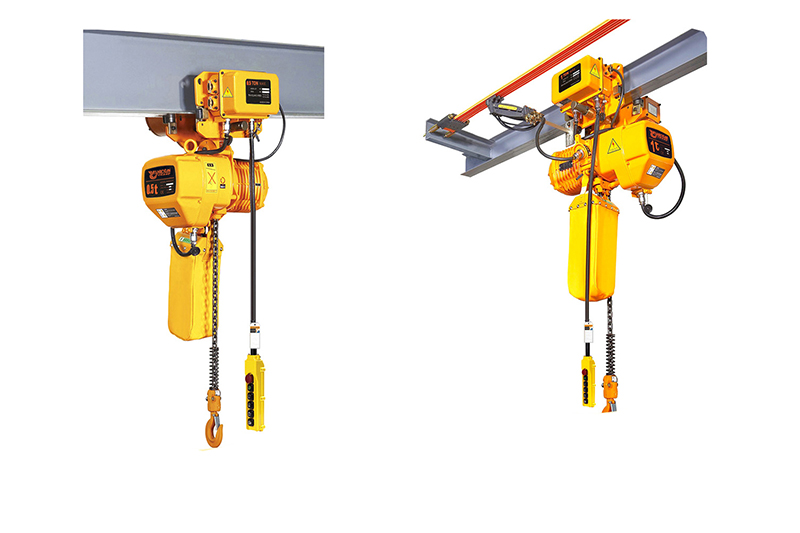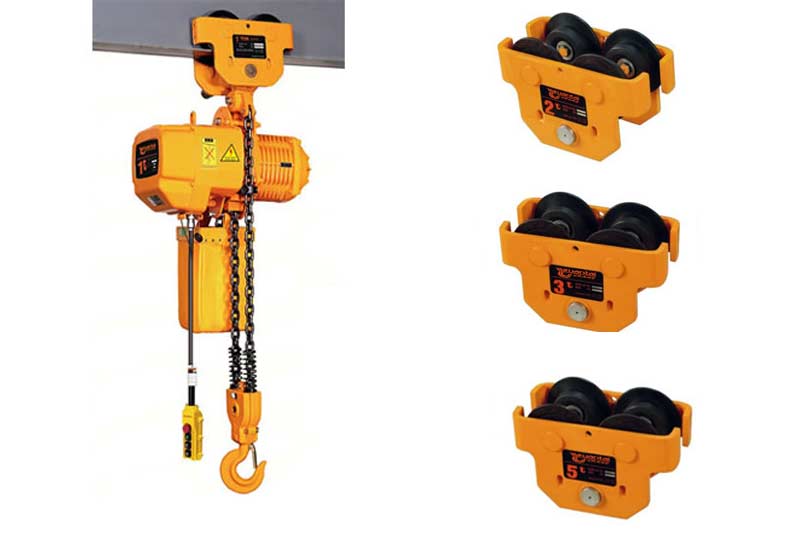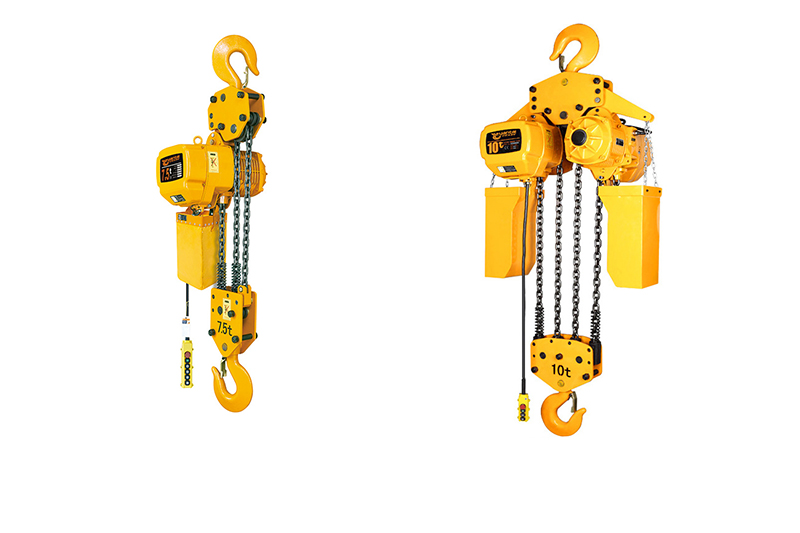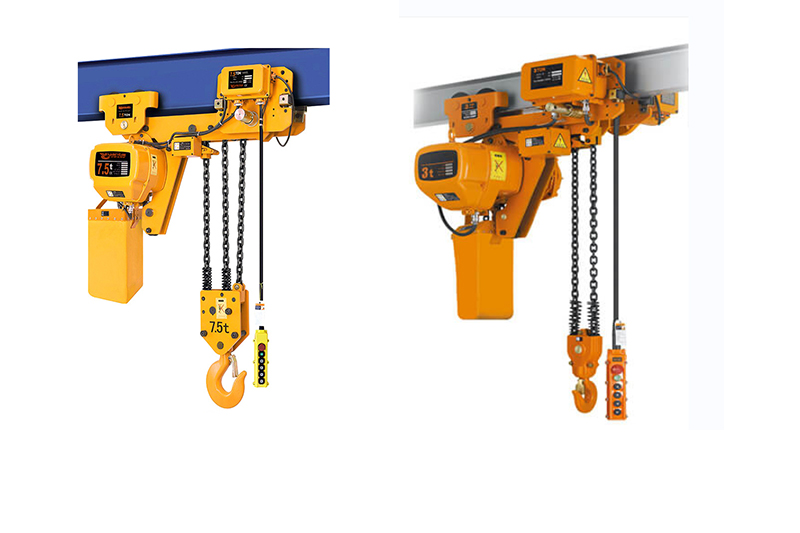Electric Chain Hoists For Sale : Motorized vs. Manual, Hook-Mounted vs. Low Headroom
Electric Chain Hoists For Sale : Motorized vs. Manual, Hook-Mounted vs. Low Headroom
Explore electric chain hoists: motorized vs. manual, hook-mounted vs. low headroom options for efficient and versatile lifting solutions.
url:electric-chain-hoist-comparison
Overview of Electric Chain Hoists
Electric chain hoists are essential lifting devices used in various industries to move heavy loads vertically. They operate by using an electric motor to drive a chain, which lifts and lowers the load. These hoists come in different configurations and designs to suit various operational needs.
Electric chain hoists are mechanical devices designed to lift and lower loads by means of an electric motor that drives a chain. They are crucial in industrial settings for tasks such as loading, unloading, and moving materials in manufacturing, warehousing, and construction. Their main purpose is to enhance productivity by making lifting tasks more efficient and less physically demanding.
In industrial applications, electric chain hoists are valued for their reliability and efficiency. They help reduce manual labor, minimize lifting time, and increase safety by handling heavy loads with precision. Whether in a factory, warehouse, or construction site, these hoists streamline operations and improve overall productivity.
The differences between motorized and manual electric chain hoists, as well as hook-mounted and low headroom models, is essential for making informed purchasing decisions. This comparison aims to clarify the features and benefits of each type, helping you select the most suitable hoist based on your specific operational requirements and workspace constraints. By exploring these options, you can make a well-informed choice that aligns with your needs and ensures optimal performance in your lifting operations.
Motorized vs. Manual Electric Chain Hoists
Motorized Electric Chain Hoists
Motorized electric chain hoists operate using an electric motor to drive the chain and lift or lower loads. When powered on, the motor engages a gearbox that moves the chain, which then moves the hook or lifting attachment up and down. Key components include the motor, gearbox, chain, hook, and control system. The motor provides the necessary power, while the gearbox adjusts the speed and torque to handle different load capacities.
Advantages
- Efficiency and Ease of Use: Motorized hoists offer faster lifting and lowering speeds compared to manual models, increasing overall efficiency in material handling. They are operated with a push-button control, making them easy to use, even for heavy or frequent lifting tasks.
- Reduced Physical Effort: Since the motor handles the lifting, operators do not need to exert physical effort, reducing the risk of fatigue and injury. This makes motorized hoists ideal for heavy and repetitive lifting tasks.
- Enhanced Control and Precision: Electric chain hoists provide precise control over load movement, allowing for smoother and more accurate positioning. This precision is particularly beneficial in applications requiring careful handling of sensitive or valuable materials.
Disadvantages
- Higher Initial Cost: Motorized hoists generally have a higher upfront cost compared to manual models. The cost includes the motor, control systems, and installation, which can be a significant investment for some businesses.
- Maintenance and Power Requirements: Motorized hoists require regular maintenance to ensure optimal performance and longevity. They also depend on a reliable power source, which can be a limitation in environments with unstable electrical supply or where power access is restricted.
Manual Trolley Electric Chain Hoists
Manual electric chain hoists rely on manual effort to lift and lower loads, typically using a hand chain or lever. The operator pulls or cranks the chain manually, which drives the gears and lifts the hook or load. Key components include the hand chain, gears, chain, hook, and manual control mechanism. This simple design eliminates the need for an electric motor, making the hoist operate solely through human power.
Advantages
- Cost-effectiveness: Manual electric chain hoists are generally less expensive than motorized models due to their simpler design and lack of electrical components. This makes them a cost-effective option for businesses with budget constraints or for occasional lifting needs.
- Simplicity and Reliability: The mechanical nature of manual hoists results in fewer components that can fail compared to motorized versions. This simplicity translates to high reliability and less frequent breakdowns, which can be advantageous in environments where maintenance resources are limited.
- No Power Source Required: Since manual hoists do not rely on electricity, they can be used in locations without a stable power supply. This feature makes them suitable for remote or temporary job sites where power availability might be an issue.
Disadvantages
- Requires Physical Effort: Operating a manual chain hoist involves physical effort from the user, which can be tiring, especially for heavy loads or extended use. This can limit the efficiency of lifting operations and may not be ideal for tasks requiring high throughput.
- Limited to Lower Capacities: Manual hoists are typically designed for lighter loads compared to motorized models. They may not be suitable for handling very heavy or large loads, which can restrict their use in high-capacity applications.
Hook-Mounted vs. Low Headroom Electric Chain Hoists
Hook-Mounted Electric Chain Hoists
Hook-mounted electric chain hoists are designed to be suspended from a hook or other hanging point, allowing the hoist to move freely along the hook's path. They operate by using an electric motor to drive a chain, which lifts and lowers the load. The key components include the hook mount, motor, chain, gearbox, and control system. This mounting style provides flexibility in how and where the hoist is used.
Advantages
- Versatility in Various Applications: Hook-mounted hoists can be used in a wide range of applications due to their ability to be easily suspended from different types of support structures. This versatility makes them suitable for diverse tasks and environments, from warehouses to construction sites.
- Easier Installation and Maintenance: The installation of hook-mounted hoists is typically straightforward, as they can be suspended from existing structures without needing additional supports. Maintenance is also simpler because the hoist can be easily accessed for routine checks and repairs.
Disadvantages
- Requires Sufficient Headroom: Hook-mounted hoists need ample vertical space above the load to operate effectively. This requirement means they may not be ideal for environments with limited headroom, such as low-ceilinged workshops or tight spaces.
- May Not Be Suitable for Space-Constrained Environments: In areas where space is at a premium, the hook-mounted design can be less practical. The need for sufficient vertical clearance can limit their use in compact or crowded work areas, potentially restricting their application in some settings.
Low Headroom Electric Chain Hoists
Low headroom electric chain hoists are specifically designed for environments with limited vertical space. They feature a compact design that minimizes the distance between the hoist’s mounting point and the load. This is achieved through a combination of specialized gearboxes and compact components that reduce the overall height of the hoist. Key components include the low-profile hoist unit, chain, motor, gearbox, and a mounting system that supports the reduced headroom design.
Advantages
- Ideal for Low Clearance Areas: Low headroom hoists are perfect for locations with minimal vertical clearance, such as low-ceilinged warehouses or industrial spaces. Their design allows for efficient lifting and lowering operations even when headroom is restricted.
- Maximizes Vertical Lifting Space: By reducing the space taken up by the hoist unit, these models allow for greater lifting heights within a limited vertical area. This maximizes the use of available space and improves the efficiency of lifting operations in constrained environments.
Disadvantages
- Potentially Higher Cost: The specialized design and engineering required for low headroom hoists can result in a higher purchase price compared to standard models. This increased cost reflects the advanced technology and materials used to achieve the compact design.
- Limited by Specific Design Constraints: While low headroom hoists excel in tight spaces, their design constraints may limit their application. They may not be as versatile as other types of hoists in terms of handling larger loads or fitting into varying mounting configurations.
Comparing the Two Configurations
Efficiency and Performance
Motorized vs. Manual: Speed and Load Handling
- Motorized Electric Chain Hoists: These hoists are designed for high efficiency and fast operation. They offer quick lifting and lowering speeds, which enhances productivity in environments with frequent lifting tasks. Motorized models are capable of handling a wide range of load capacities with precise control, making them suitable for high-volume and heavy-duty applications.
- Manual Electric Chain Hoists: Manual hoists, on the other hand, operate at a slower pace and require physical effort from the user. They are less efficient for high-speed or high-volume lifting due to their reliance on manual operation. While they can handle various loads, their performance is limited by the physical strength of the operator and the frequency of use.
Hook-Mounted vs. Low Headroom: Operational Range and Space Utilization
- Hook-Mounted Electric Chain Hoists: These hoists offer flexibility in operational range as they can be suspended from various support structures. They are ideal for applications where vertical space is not a constraint and allow for movement across different points of attachment. However, they require adequate headroom to function effectively.
- Low Headroom Electric Chain Hoists: Designed specifically for tight spaces, low headroom hoists maximize vertical lifting capabilities within limited clearance areas. They are well-suited for environments with restricted overhead space, allowing for efficient use of available vertical space. However, their design constraints may limit their operational range and versatility compared to hook-mounted models.
Cost Considerations
Initial Purchase Cost
- Motorized Electric Chain Hoists: Generally have a higher initial purchase cost due to their complex components, including the motor, control systems, and advanced features. This investment can be justified by their enhanced efficiency and reduced labor requirements.
- Manual Electric Chain Hoists: Typically more affordable, as they lack electric motors and sophisticated controls. The lower cost makes them a cost-effective choice for operations with less frequent lifting needs or smaller budgets.
Long-Term Maintenance and Operational Costs
- Motorized Electric Chain Hoists: Require regular maintenance to ensure optimal performance and longevity, including checks on the motor and control systems. They also incur ongoing operational costs related to power consumption. Despite these costs, their high efficiency and reduced manual effort can lead to overall cost savings in high-usage scenarios.
- Manual Electric Chain Hoists: Generally involve lower maintenance and operational costs due to their simpler design and lack of electrical components. They do not require power and have fewer parts that can wear out, resulting in lower long-term expenses. However, the physical labor involved may affect productivity and efficiency.
Application Suitability
Best Use Cases for Motorized vs. Manual
- Motorized Electric Chain Hoists: Best suited for environments with high lifting frequency, heavy loads, and where speed and precision are crucial. They are ideal for manufacturing facilities, warehouses, and construction sites where efficiency and reduced physical labor are prioritized.
- Manual Electric Chain Hoists: Suitable for lower frequency lifting tasks, smaller loads, and environments where cost is a primary concern. They are often used in smaller workshops, maintenance areas, and locations where power availability is limited or unnecessary.
Best Use Cases for Hook-Mounted vs. Low Headroom
- Hook-Mounted Electric Chain Hoists: Ideal for applications where headroom is not a limiting factor, such as in open spaces or areas with ample vertical clearance. They offer flexibility in mounting and can be used in various lifting scenarios.
- Low Headroom Electric Chain Hoists: Best for environments with restricted vertical space, such as low-ceilinged warehouses or tight workshops. Their design maximizes lifting capabilities within limited headroom, making them perfect for compact or confined areas where vertical space is at a premium.
Choosing the Right Electric Chain Hoist
Factors to Consider
- Load Capacity Requirements:Determine the maximum weight that needs to be lifted regularly. Electric chain hoists come in various capacities, and selecting one that meets or exceeds your load requirements is crucial for safe and efficient operation. Assess both the maximum load and the typical load to ensure the hoist can handle your needs without strain.
- Workspace and Clearance Constraints:Evaluate the physical space where the hoist will be installed. If headroom is limited, a low headroom hoist might be necessary to operate efficiently. Conversely, if space is not an issue, a hook-mounted hoist could provide greater flexibility. Consider the height and layout of your workspace to choose a hoist that fits comfortably and operates effectively.
- Frequency of Use and Operational Environment:Consider how often the hoist will be used. Motorized hoists are ideal for frequent or high-volume lifting tasks due to their efficiency and ease of use. Manual hoists might be more suitable for occasional or lighter lifting needs. Additionally, think about the operational environment, such as exposure to harsh conditions or potential hazards, which may affect the choice of hoist type.
Recommendations Based on Application
Scenarios for Selecting Motorized vs. Manual
- Motorized Electric Chain Hoists: Choose these if you have high-frequency lifting operations, require quick and precise load handling, or need to lift heavy loads with minimal physical effort. Ideal for large-scale manufacturing facilities, busy warehouses, and construction sites where efficiency and speed are critical.
- Manual Electric Chain Hoists: Opt for these if your lifting tasks are infrequent, involve lighter loads, or are in locations with limited access to power. Suitable for smaller workshops, maintenance areas, or environments where cost is a primary concern and lifting demands are not as intensive.
Scenarios for Selecting Hook-Mounted vs. Low Headroom
- Hook-Mounted Electric Chain Hoists: Ideal for environments with ample vertical clearance and where flexibility in mounting is beneficial. Suitable for open spaces, areas with adjustable mounting points, and applications where the hoist can be freely suspended from various supports.
- Low Headroom Electric Chain Hoists: Best for situations where vertical space is constrained, such as low-ceilinged warehouses or compact workshops. These hoists maximize vertical lifting within tight spaces, making them ideal for environments where headroom is limited but efficient lifting is still required.
Customized Electric Chain Hoist for You
In comparing electric chain hoists, the choice between motorized and manual models, as well as hook-mounted and low headroom configurations, is crucial for optimizing lifting operations. Motorized hoists offer enhanced efficiency, ease of use, and precision, making them ideal for high-frequency and heavy-duty applications. Manual hoists, while more cost-effective and simple, require physical effort and are better suited for less frequent or lighter lifting tasks. On the other hand, hook-mounted hoists provide flexibility in various applications with fewer installation constraints, whereas low headroom hoists are designed specifically for environments with limited vertical space, maximizing lifting capacity in tight areas.
Choosing the right electric chain hoist involves aligning the hoist type with your specific application needs. Consider factors such as load capacity, workspace constraints, and frequency of use to make an informed decision. By selecting the appropriate hoist, you can ensure efficient and safe lifting operations, tailored to the unique requirements of your environment and operational demands.




